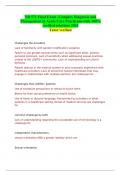Summary
Samenvatting MMSR Videolectures & Assignments - Methodology Marketing Strategic Management Research - RU - MAN-MMA032A
- Course
- Institution
Een samenvatting van het vak Methodology Marketing & Strategic Management Research. De samenvatting gaat over de lectures en de assignments en verduidelijkt de stof d.m.v. screenshots uit SPSS/ de assignments. Deze samenvatting is geschreven in het Engels.
[Show more]












